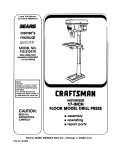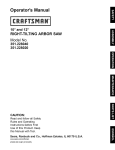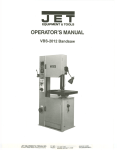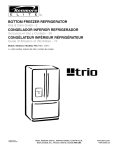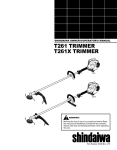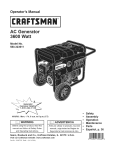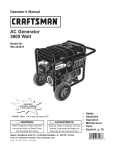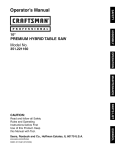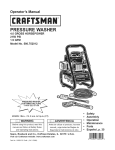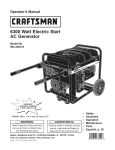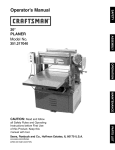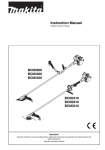Download Craftsman 351.21 4300 Operator`s manual
Transcript
Operator's Manual CRAFTSMAN ++ _ PROFESSI ONAL_ 1 8" Metal Cutting BAND SAW WITH WELDER Model No. 351.21 4300 CAUTION: Read and follow all Safety Rules and Operating Instructions before First Use of this Product. Sears, Roebuck and Co., Hoffman www.sears.com/craftsman 25173.01 Draft (05/21/07) Estates, IL 60179 U.S.A. BE PREPARED Warranty .................................... SafetyRules............................... Unpacking.................................. Assembly ................................... Installation ................................. Operation................................ Maintenance ................................ Troubleshooting ........................... PartsIllustrations andLists.................. 2 2-3 3 3 3-5 5-11 11 12-13 14-23 FOR JOB • Wear proper apparel. Do not wear loose clothing, gloves, neckties, rings, bracelets or other jewelry which may get caught in moving parts of machine. • Wear protective hair covering to contain long hair. • Wear safety shoes with non-slip soles. • Wear safety glasses complying with United States ANSI Z87.1. Everyday glasses have only impact resistant lenses. They are NOT safety glasses. • Wear face mask or dust mask if operation is dusty. • Be alert and think clearly. Never operate power tools when tired, intoxicated or when taking medications that cause drowsiness. PREPARE WORK AREA FOR JOB • Keep work area clean. Cluttered work areas invite accidents. • Do not use power tools in dangerous environments. Do not use power tools in damp or wet locations. Do not expose power tools to rain. • Work area should be properly lighted. • Proper electrical receptacle should be available for tool. Three-prong plug should be plugged directly into properly grounded, three-prong receptacle. • This warranty gives you specific legal rights and you may also have other rights which vary from state to state. Extension cords should have a grounding prong and the three wires of the extension cord should be of the correct gauge. • Keep visitors at a safe distance from work area. Sears, Roebuck and Co., Hoffman Estates, IL 60179 • Keep children out of workplace. Make workshop childproof. Use padlocks, master switches or remove switch keys to prevent any unintentional use of power tools. WARNING: Some dust created by power sanding, sawing, grinding, drilling and other construction activities contains chemicals known to cause cancer, birth defects or other reproductive harm. TOOL SHOULD ONE-YEAR FULL WARRANTY CRAFTSMAN PROFESSIONAL ON TOOL If this Craftsman tool fails due to a defect in material or workmanship within one year from the date of purchase, call 1-800-4-MY-HOME® TO ARRANGE FOR FREE REPAIR (or replacement if repair proves impossible). This warranty does not include expendable parts, such as lamps, batteries, bits or blades. If this tool is ever used for commercial or rental purposes, this warranty will apply for only 90 days from the date of purchase. Some examples of these chemicals are: • Lead from lead-based paints. • Crystalline silica from bricks and cement and other masonry products. • Arsenic and chromium from chemically-treated lumber. Your risk from these exposures vary, depending on how often you do this type of work. To reduce your exposure to these chemicals: work in a well ventilated area and work with approved safety equipment. Always wear OSHA/NIOSH approved, properly fitting face mask or respirator when using such tools. WARNING: For your own safety, read all of the instructions and precautions before operating tool. CAUTION: Always follow proper operating procedures as defined in this manual -- even if you are familiar with use of this or similar tools. Remember that being careless for even a fraction of a second can result in • Always unplug tool prior to inspection. • Consult manual for specific maintaining and adjusting procedures. • Keep tool lubricated and clean for safest operation. • Remove adjusting tools. Form habit of checking to see that adjusting tools are removed before switching machine on. • Keep all parts in working order. Check to determine that the guard or other parts will operate properly and perform their intended function. • Check for damaged parts. Check for alignment of moving parts, binding, breakage, mounting and any other condition that may affect a tool's operation. • A guard or other part that is damaged should be properly repaired or replaced. Do not perform makeshift repairs. (Use parts list provided to order replacement parts.) KNOW HOW TO USE TOOL • Use right tool for job. Do not force tool or attachment to do a job for which it was not designed. • Disconnect tool when changing blade. severe personal injury. © Sears, Roebuck and Co. BE MAINTAINED 2 • Avoid accidental start-up. Make sure that the tool is in the "off" position before plugging in. • Do not force tool. It will work most efficiently at the rate for which it was designed. • Keep hands away from moving parts and cutting surfaces. • Never leave tool running unattended. Turn the power off and do not leave tool until it comes to a complete stop. • Do not overreach. Keep proper footing and balance. • Never stand on tool. Serious injury could occur if tool is tipped or if blade is unintentionally contacted. • Know your tool. Learn the tool's operation, application and specific limitations. • Use recommended accessories (refer to page 17). Use of improper accessories may cause risk of injury to persons. • Handle workpiece correctly. Protect hands from possible injury. • Turn machine off if it jams. Blade jams when it digs too deeply into workpiece. (Motor force keeps it stuck in the work.) Do not remove summed or cut off pieces until the saw is turned off, unplugged and the blade has stopped. WARNING: The operation of any power tool can result in foreign objects being thrown into the eyes, which can result in severe eye damage. Always wear safety goggles complying with United States ANSI Z87.1 (shown on package) before commencing power tool operation. Safety goggles are available through your Sears catalog. WARNING: Be careful not to touch overhead power lines, piping, lighting, etc., if lifting equipment is used. Band saw weighs approximately 1000 Ibs. Proper tools, equipment and qualified personnel should be employed in all phases of unpacking and installation. IMPORTANT: Table is coated with a protectant. To ensure proper fit and operation, remove coating. Coating is easily removed with mild solvents, such as mineral spirits, and a soft cloth. Avoid getting solution on paint or any of the rubber or plastic parts. Solvents may deteriorate these finishes. Use soap and water on paint, plastic or rubber components. After cleaning, cover all exposed surfaces with a light coating of oil. Paste wax is recommended for table top. WARNING: Never use highly volatile solvents. Non flammable solvents are recommended to avoid possible fire hazard. Refer to Figure 16. CAUTION: Do not attempt assembly if parts are missing. Use operator's manual to order replacement parts. MOUNT RIP FENCE Refer to Figure 16. Thread rip fence lock knob into rip fence (Key Nos. 43 and 42) and slide rip fence into groove on top of work table. Secure rip fence with lock knob. Refer to Figures 2-5, 14 and 17. Check for shipping damage. If damage has occurred, a claim must be filed with carrier. Check for completeness. Immediately report missing parts to dealer. The band saw comes assembled as one unit. Additional parts which need to be fastened to the saw should be located and accounted for before assembling: A Rip Fence B Knob MOTOR The 115/230 Volt AC motor has the following specifications: Horsepower (Continuous Duty) ................. Voltage ............................... 11/2 115/230 Amps .................................... Hertz ..................................... Phase .................................. RPM .................................... 18/9 60 Single 1720 Before band saw is installed, a suitable location should be chosen. Band saw weighs approximately 1000 Ibs. 1. Band saw needs to be set on a flat, level surface. B Figure 1 - Unpacking Unbolt saw from shipping pallet and remove saw from crate using eye bolt on saw and heavy duty lifting equipment such as an overhead crane. 2. Make sure there is ample room for moving the workpiece through the entire cut. There must be enough room that neither the operator nor bystanders will have to stand in line while using the tool. 3. Good lighting and correct power supply are also required for a proper work area. Mount saw on level surface using mounting brackets welded to cabinet. Bolt cabinet to floor (hardware not included). POWER SOURCE Check with a qualified electrician if grounding instructions are not understood or if in doubt as to whether the tool is properly grounded. Band saw requires a 115 or 230 volt, 60 Hz power source. Band saw is shipped with motor and controls prewired for 115 volt operation. Line cord does not have plug. A 115 volt, 20/30A three-prong plug must be attached to the line cord. Green (or green and yellow) conductor in cord is the grounding wire. If repair or replacement of the electric cord or plug is necessary, do not connect the green (or green and yellow) wire to a live terminal. The motor is designed for operation on the voltage and frequency specified. Normal loads will be handled safely on voltages not more than 10% above or below the specified voltage. Many cover plate screws, water pipes and outlet boxes are not properly grounded. To ensure proper ground, grounding means must be tested by a qualified electrician. Running the unit on voltages which are not within the range may cause overheating and motor burn-out. Heavy loads require that the voltage at motor terminals be no less than the voltage specified. Power supply to the motor is controlled by a double pole locking rocker switch. Remove the key to prevent unauthoriFed use. GROUNDING To use the band saw with a 230V power supply: WARNING: All electrical connections must be performed by a qualified electrician. INSTRUCTIONS WARNING: Improper connection of equipment grounding conductor can result in the risk of electrical shock. Equipment should be grounded while in use to protect operator from electrical shock. • Have a qualified electrician attach a 230 volt, 20/30A 3-prong plug band saw line cord. • Open cover (Figure 17, Key No. 8) by removing eight pan head screws. • Change wire from 115V terminal of transformer to the unused 230V terminal (See Figure 2). • Change amperage setting on the thermal overload relay (See Figure 2). • Replace cover. Change overload AMP setting to 9 AMP for 230V Operation Wire change for 230V Operation On Wir/e change for 230V Operation Weld Limit Switch Led Lamp Saw Motor co Power Figure 2 - Control Wiring Schematic 4 Rewire saw motor to 230 volts (See Figure 3). EXTENSION CORDS • The use of any extension cord will cause some drop in voltage and loss of power. • Wires of the extension cord must be of sufficient size to carry the current and maintain adequate voltage. Use the table to determine the minimum wire size • (A.W.G.) extension cord. 115V • Use only 3-wire extension cords having 3-prong grounding type plugs and 3-pole receptacles which accept the tool plug. • If the extension cord is worn, cut or damaged in any way, replace it immediately. EXTENSION CORD LENGTH 230V Wire Size Figure 3 - Saw Motor Wiring Diagram • Remove pan head screws from welder cover (Figure 14, Key No. 1) tilt welder outwards. • Rewire welding transformer to 230 volts (See Figure 4). R N Cv 35V 1 V A.W.G. Up to 25 ft .................................. 25 to 50 ft .................................. 14 12 NOTE: Using extension cords over 50 ft. long is not recommended. ELECTRICAL CONNECTIONS WARNING: All electrical connections must be performed by a qualified electrician. Make sure unit is off and disconnected from power source while motor is mounted, connected, reconnected or anytime wiring is inspected. V 230V 115V N C 35V 115V V 2 R V 230V Figure 4 - Welder Transformer Wiring Diagram • Rewire grinder motor to 230 volts (See Figure 5). 115V 230V Figure 5 - Grinder Motor Wiring Diagram • Secure welder cover to saw column using pan head screw. Craftsman 18" Vertical Metal Cutting Band Saw provides precision metal cutting for tool and die makers, machine shops and production work. Blade speed is infinitely variable and ranges from 80 FPM to 385 FPM for cutting ferrous and non-ferrous metal. Selection guide helps determine blade type and speed for most metals. Features include industrial rated heavy duty speed reducer, heavy gauge steel construction, cast iron wheels, pulleys, table and LED blade speed indicator. Saw is controlled by push button magnetic switch with safety off button and key lock switch. Saw comes with a 115/230 volt motor prewired for 115 volts. Saw features tilting work table for angle cuts, built-in chip chute, eye bolt for moving, chip blower, flange mounting brackets for securing saw to the floor, blade welder and work lamp. Blade widths of '/8-5/8 '' and thickness of 0.020 to 0.035" can be welded for convenient production of band saw blades. Welder features a blade shear, grinder and an anneal button. SPECIFICATIONS Depth of throat ............................. 18" Maximum depth of cut ...................... 10s/4'' Table size ........................... 23% x 21%" Table tilt ............................ -15 to +15 ° Wheel diameter ............................ CAUTION: Do not operate the band saw and the welder at the same time. 18" Blade length .............................. 140" Blade width ............................. Blade speeds .... The control panel for the blade welder is shown in Figure 7. The welding circuitry is energized independent of the band saw circuitry. To operate the welder, plug in the line cord to a proper power source. Anneal Button 1/8to %" Weld Pressure -- Adjustment Knob Weld Button -- infinitely variable from 80 to 385 FPM Overall dimensions .................. 75 x 37 x 30" Shipping weight ........................ 1012 Ibs Dust collection port ........................... cTD, Movable Jaw -- Stationary Jaw 4" CAUTION: Always observe the following safety precautions: ....Jaw Clamping Handles • Make sure that blade guides and thrust bearings are positioned and adjusted correctly to prevent sideways and rearward movement of the blade. Adjust upper guide to just clear workpiece. • Check to make sure blade is tensioned and tracking properly. Do not over tension the blade in order to prevent premature blade wear and breakage. Avoid under tensioning to eliminate back and forth, side to side blade movement as it cuts. • Use proper blade and speed for the cutting operation. Figure 7 - Blade Welder Control • After turning saw on, allow blade to come to full speed before attempting any cutting operation. REMOVING • Grinder Switch - @ Keep hands away and out of line with moving parts. • Always wear eye protection. BLADE Refer to Figures 15 and 16. Support workpiece properly and use a smooth steady feed to guide work through the cut. Use push sticks or push blocks when required. • @ WARNING: Disconnect band saw from power source when changing or adjusting blades. Wear leather gloves when handling band saw blades. Never wear gloves when operating saw. • Turn handwheel (Figure 15, Key No. 38) counterclockwise. This lowers the idler wheel (Figure 15, Key No. 5) and relieves tension in blade. Band saw control panel has three functional operations: • ON - Green color push button that energizes the magnetic contactor to start the band saw. Remove blade guard (Figure 16, Key No. 39) by loosening screws (Figure 16, Key No. 49). • OFF - Red color push button that deenergizes the magnetic contactor to stop the band saw. To restart the saw, turn the knob to reset and depress the ON button. Pull handle (Figure 15, Key No. 69) to open upper and lower doors (Figure 15, Key Nos. 36 and 67). • Be careful, blade may spring from saw. • Remove blade from wheels and guide it out through table slot. OPERATING SAW CONTROLS Refer to Figures 6 and 7. KEY - Key switch locks machine to prevent unauthorized use. INSTALLING BLADE Key • Although many of the adjustments may not be altered when blade is removed, every adjustment should be checked prior to using a newly installed blade. • Follow safety precautions every time saw is operated. • Make sure blade teeth are pointing down towards table. Turn blade inside out if necessary. Slip new blade into table slot and over upper and lower blade wheels and center blade on blade wheels. Slide blade in between blade guides. Replace table stud. Replace blade guards after blade guide adjustment. • Off On ÷ • Figure 6 - Band Saw Control 6 Tension and track blade as described in the following sections. TENSIONING BLADE 0.002" Refer to Figure 15. • Tension blade by rotating handwheel (Key No. 38). Be sure blade guides do not interfere with blade path. • Tighten blade until it is properly tensioned. 0.002" Blade Guide • A properly tensioned blade will ring slightly when back of blade is plucked (like a string on an instrument). NOTE: Check tension of new blade. Additional tension may be required after a few minutes of operation. TRACKING BLADE Refer to Figure 15. • Track blade after it has been tensioned. A change in blade tension will affect wheel alignment. Proper tracking is achieved when upper and lower wheels are aligned. • Set screws (Key No. 23) are used to align the tracking bracket to the saw frame. • Turn idler wheel (Key No. 5) by hand and observe how blade rides on the wheels. • If blade rides away from the cabinet, tilt wheel up by turning knob (Key No. 30) clockwise. • If blade rides into cabinet, tilt wheel down by turning knob counterclockwise. ADJUSTING BLADE Blade Figure 8 - Blade Guide Adjustment NOTE: 0.002" gap between blade and both blade guides. BLADE • Consult Blade Speed Chart to determine blade speed and blade type for required cutting operation. Blades vary depending on type of material, size of workpiece and type of cut that is being performed. Characteristics which make blades different are width, thickness, type of tooth and blade pitch. • Width of blade describes distance from tip of a tooth to back of blade. Width of blade will affect rigidity of blade. A wider blade will wander less and produce a straighter cut. Width of blade also limits the smallest radius which can be cut. A 1/Z' wide blade can cut about a 1/2" radius. Blade thickness describes the distance between sides of blade. A thicker blade has more rigidity and stronger teeth. A narrow thick blade would be used to cut curves in piece while a wide thin blade would be used to make long, straight cuts. GUIDES • Blade guide bracket (Key No. 20) should be positioned so guide blocks (Key No. 21 ) on either side of blade will support as much of blade width as possible without interfering with the tooth set. • Adjust guide bracket depth by loosening set screw (Key No. 40) and sliding bracket into position. Secure position of bracket by tightening set screw. Loosen bolts (Key No. 24) and adjust guide blocks (Key No. 21 ) to sides of blade. Use a feeler gauge to check that guide blocks are 0.002" away from blade. • • • • Lock adjustment by tightening bolts. Adjust the height of upper guide assembly to clear the workpiece by 1/4".Loosen locking knob (Key No. 30) and use handle (Key Nos. 37 and 38) to slide guide bar down until the upper guide assembly clears workpiece by 1/4".Tighten locking knob. Lower blade guides employ two guide blocks for side support. Lower guide bracket is spaced close to table surface to minimize unsupported length of blade. • • Loosen bolts (Key No. 26) to adjust lower guide bracket (Key No. 19) so guide blocks do not interfere with blade set. Loosen socket head bolts (Key No. 24) for guide blocks (Key No. 21) and adjust guide blocks to 0.002" from each side of blade. Blade manufacturers are prepared to supply information about blades for specific applications. BLADE PITCH Refer to Blade Speed Chart. • Pitch describes number of teeth per inch. A blade with more teeth per inch will produce a smoother cut. • Type of material being cut determines number of teeth in contact with work. • There should always be at least three teeth in contact with workpiece to avoid shocking blade. Blade shocking occurs when pitch is too large and blade tooth encounters too much material. This can strip teeth from blade. • When pitch is too small the gullets of the teeth will fill up, leading to the creation of excess heat. NOTE: Lower blade guard (Key No. 56) must be removed to adjust lower blade guides. • AND TYPE SELECTION Refer to Blade Speed Chart. Refer to Figures 8 and 16. NOTE: Adjust blade guides only after blade has been properly tensioned and tracked. • Blade guides support blade at sides and rear of blade, and prevent twisting or deflection. • Upper blade guides employ guide blocks for side support and a grooved bracket at rear. SPEED MATERIAL Highcarbonsteel Freecuttingsteel Ferro-manganese Ferro-nickel Ferro-nickel-chrome Ferro-molybdenum Ferro-chrome (med.) Ferro-chrome (high) Manganese steel Ferro-tungsten Ferro-chrome-vanadium Ferro-silicon-manganese Machinery steel Ordinarytoolsteel Highspeedsteel Stainlesssteel Thickironplate Castiron Nickelcastiron Forgeable castiron Highgradecastiron Coarsecastiron Tombac Bronze Phosphorus-bronze Nickelaluminumbronze Magnesium-bronze Hard aluminum Aluminum Copper Fibers Asbestos THICKNESS: 1/4" 230/18 200/18 200/18 165/18 130/24 150/18 165/18 100/24 180/18 150/18 165/18 150/18 180/18 130/24 100/24 130/18 165/18 200/18 200/18 200/18 150/18 200/18 1480/18 245/18 490/18 490/18 1/4-1" 200/14 150/14 156/14 130/14 100/18 130/14 100/14 75/14 150/14 100/14 100/14 130/14 130/14 100/18 75/14 100/14 130/12 200/14 150/12 165/14 130/14 165/14 1000/12 245/12 295/14 295/12 295/18 2000/18 2000/18 395/18 1480/24 1300/24 245/12 2000/10 1650/10 295/12 1300/18 1000/18 TYPE OF TOOTH • The shape of teeth are varied to achieve specific cutting results. A blade cuts work by removing material. Blade teeth must scrape a chip of workpiece away on each cut. • The shape of gullet between teeth determines how much material can be taken out with each blade tooth. • There should always be at least three teeth in contact with workpiece to avoid shocking blade. Blade shocking occurs when pitch is too large and blade tooth encounters too much material. This can strip teeth from blade. • When pitch is too small, gullets of teeth will fill up leading to creation of excess heat. • Rake angle is the angle which the cutting face of tooth makes with a line perpendicular to the back of blade. A 0 ° rake angle is used to cut hard materials. .3 tt .6 200/10 130/12 130/12 100/12 75/14 100/12 75/12 66/10 115/12 75/12 75/12 100/10 115/12 100/14 66/12 75/10 75/10 150/12 100/8 150/10 100/10 130/10 750/8 225/10 200/10 225/10 225/10 2000/8 1300/6 245/8 1000/6 660/14 tr 150/6 100/6 100/8 75/8 66/8 75/8 66/8 66/8 100/8 66/8 66/8 75/6 100/6 80/8 66/8 66/8 66/8 75/8 66/6 130/6 75/6 75/6 95/6 200/6 150/6 150/6 150/6 2000/6 820/4 150/6 750/4 490/10 6-1 O" 150/4 100/4 100/4 75/4 66/6 75/6 66/6 66/6 66/4 66/4 66/4 75/4 66/4 75/4 66/4 66/4 66/4 75/4 66/4 130/4 66/4 75/4 295/4 150/4 150/4 150/4 150/4 1480/4 490/3 150/3 750/3 330/6 • Positive rake angle blades are used to cut softer materials. Softer materials require more aggressive chip removal. • Larger gullets provide for faster removal but have to be limited in size because they make blade teeth weaker. • Blade teeth will also vary in the way that teeth have been set from one side to the other. A wider set is used for contour work because wider kerf allows operator to cut tighter curves. CHANGING BLADE SPEED Refer to Figure 15. WARNING: Never adjust blade speed unless machine is running or damage to saw may result. • 8 Blade speed is adjusted by rotating handwheel (Key No. 50) while machine is running. Rotate handwheel clockwise to increase blade speed. Rotate handwheel counterclockwise to decrease blade speed. The blade speed is shown on LED display located above switches. ADJUSTING TABLE ANGLE MITER GAUGE Refer to Figure 16. • Angle cuts can be made by tilting table left to right. Loosen socket head bolts (Key No. 12) to tilt table up to 15 ° right or left. Use angle scale to set table angle (Key No. 18). Use miter gauge (not provided) for securing and holding workpiece at desired angle to produce angled cuts. Use scale to adjust gauge to desired angle. • Never at the piece. could TYPE OF CUT • Band saw can be used to perform a variety of cuts. Cutting procedure used depends on size and desired shape of cut. use miter gauge (not provided) and rip fence same time. The blade might bind in the workOperator could be injured and/or workpiece be damaged. PREPARING BLADE FOR WELDING • The rip fence is used to guide workpiece to produce straight cuts on longer pieces. • • Contour cutting is done by guiding workpiece freehand to produce curved shapes. • The blade must be cut to proper length. • Blade ends should be cut and ground square. • Beveled cutting can be done with any proper work guide method by tilting table. • Any rust, oil or dirt must be removed. • • Regardless of which method is used, a workpiece which overhangs table by more than 10" should be properly supported by free standing material stands. See "Recommended Accessories," page 17. Some teeth must be ground off blade ends depending upon the pitch of the blade. USING RIP FENCE Refer to Figure 16. • Rip fence is used to guide workpiece straight into blade producing a desired width of cut. Set rip fence to desired width of cut on either side of blade. Kerr of the blade must be considered when setting up. • Lock rip fence securely with rip fence lock knob (Key No. 43). The portion of material between blade and rip fence is considered the workpiece. Material outside of blade is considered scrap to be cut off. • Guide workpiece into blade but do not push on scrap side of material. Avoid passing hands beyond blade. Use push sticks to finish cuts and pass workpiece away from blade. CONTOUR • • • • CUTTING When contour cutting, both hands must be used to keep workpiece flat against table and guided along path. Avoid placing hands in line of blade. If hands contact blade it may cause injury. Stand in front of saw and use both hands over portion of table to right of blade and before cut. Do not attempt to cut sharp corners. Cut small corners by sawing around them and removing scrap until shape is produced. BLADE • Band saw is equipped with chip blower used to remove chips to make contour cutting easier. • Adjust air nozzle (Key No. 31) so that pump air blows chips away from blade and workpiece. CUTTING Refer to Figure 9. • Cut the blade ends flat, square and smooth using the blade shear. • Lean the back of blade against the shear blade guide when cutting blade ends (See Figure 9). • Use grinder, as needed, to make blade ends flat, square and smooth. Figure 9 - Blade Cutting BLADE Butt Back of Blade Against Shear Alignment Surface MOUNTING Refer to Figure 10, page 10. • Clean welder jaw of any scale, oil, rust or dirt. Clean blade ends which contact welder jaws to provide proper electrical contact. • Set weld pressure adjustment knob to "0" (released). • Insert one end of blade into stationary jaw with teeth facing out and blade end centered between jaws. • Firmly set back of blade against back alignment surface of welder jaw and clamp blade tight with the jaw clamping handle (See Figure 10, page 10). • Insert other end of blade into movable jaw; butt the blade ends together and clamp tight. CHIP BLOWER Refer to Figure 16. A properly prepared blade is essential in producing a high-quality, long lasting band saw blade. IMPORTANT: The blade ends should butt against each other over the full width of the blade and should not overlap (See Figure 10, page 10). • Incorrect- BladesClampedAtAngle Tooth grinding procedure must be done carefully in order to grind the proper number of teeth and not to grind below gullet which would weaken the blade. BLADE WELDING Refer to Figures 7 and 12. • Incorrect - Blades Not Ground Square To set weld pressure adjustment knob, turn the knob counterclockwise to increase the pressure. The pressure adjustment knob controls force applied to the movable jaw. NOTE: Weld pressure adjustment knob must be reset to "0" after each welding. Incorrect - Blades Overlap • Correct - Grind Blades Square and Clamp Straight Wider blades and thicker blades need more weld pressure to force the blade ends together during welding. If too little pressure is applied, the blade ends will melt. Too much pressure may cause the blades to overlap. For example, for 1/2"wide blades, turn the pressure adjustment knob counterclockwise until the pointer is at 6 (See Figure 12). 5 4 Correct - Clamp Blades Flat with no Overlap 3 Figure 10 - Blade Mounting and Clamping TOOTH SPACING Refer to Figure 11. • • 2 Approximately 1/8"of blade will be consumed during the welding process. This blade loss must be taken into account. 1 All blades must have some of the teeth ground off so that the tooth spacing will be uniform after welding. % Tooth _ - % Tooth Figure 12 - Weld Pressure Adjustment 3. _ _ _ - 3/4Tooth /4 Ioottl 7_1"t'j _P:-.. 12TPI _ 3/8Tooth - _ 6TP,_ % Tooth = _ - 3/8Tooth _ 3/4Tooth ,6TP, - _ __ 1%Tooth__8TP, __ 20TP,_ 1% If blade melts, increase pressure. If there are "blow holes" in the weld, increase pressure. • If blade overlaps, decrease pressure. • Wider blades need more pressure and thinner blades need less pressure. Weld pressure is also affected by blade material. WARNING: Welding operation produces sparks at blade intersection. Step away to left side of welder during welding operation. = 3/4Tooth - _/2Tooth • WARNING: Always wear ANSI approved safety glasses during welding. Sparks from welder can cause serious injury to eyes. • Press weld button and hold down. The blade ends will become red hot and soft. The movable jaw will force the blade ends together creating a bead of metal and the limit switch will automatically cut power to jaws. Tooth _ Figure 11 - Tooth Spacing (TPI = Teeth per Inch) 10 • Release weld button and wait 10 seconds to allow blade to cool. • Reset weld pressure adjustment to "0". Heat build-up in the tool can cause serious damage to the tool. Allow transformer to cool down to room temperature between each welding or each annealing operation. It is a safe procedure to let the transformer be idle for at least 3 minutes between successive welding/annealing operations. WARNING: Make certain that unit is disconnected from power source before attempting to service or remove any component. BLADE ANNEALING CLEANING • After the blade has been welded, the weld area will be very hard and brittle. Before the blade can be used, it must be annealed and the flash removed. Refer to Figure 15. • Keep machine and workshop clean. Do not allow sawdust to accumulate on band saw. The blade weld is annealed by heating the blade just under the melting temperature and then slowly cooling the weld. • Keep wheels clean. Debris on wheels will cause poor tracking and blade slippage. • • NOTE: Reset weld pressure adjustment knob to "0" prior to annealing. Failure to do so can cause damage to transformer. Keep mechanisms and threaded or sliding surfaces clean and free of foreign particles. • Operate band saw with a dust collector to minimize clean up. • • Make sure that brush (Key No. 63) is in contact with blade to properly remove foreign particles from drive wheel. Press the anneal button until the weld area glows a cherry red and then release the anneal button. CAUTION: The blade weld will melt, destroying the weld, if the anneal button is not released as soon as the weld glows cherry red. • Let the blade cool for several seconds. • Press the anneal button again, but release the button before the weld glows as brightly as the first time. • Wait several seconds until the blade cools further. • Repeat the anneal process 6 or 7 times, decreasing the anneal temperature each time. • The weld flash must be ground from the blade. See "Grinding Blade". GRINDING • After annealing the blade, the metal buildup or flash must be ground from the blade. Toggle grinder switch to the ON position. • Flip the grinder guard open, exposing the top of the grinding wheel. • Weld should be ground to same thickness as blade. • • • The shielded ball bearings are permanently lubricated and require no further lubrication. • Grease guide post (Figure 16, Key No. 36) once a week. Grease speed operator shaft in gearbox housing (Figure 15, Key No. 28 and 45) and blade tension lead screw (Figure 15, Key No. 16) every 100 hours. Use grease gun on grease fitting every 100 hours (Figure 17, Key No. 10). Grease table support brackets every three months. • Add light machine oil or air tool oil to air pump (Figure 17, Key No. 49) when pump loses power or fails to pump air. • Occasionally apply a coat of paste wax to table top to keep it slick and corrosion free. KEEP BAND SAW IN REPAIR • If power cord is worn or cut in any way, have it replaced. Grind flash off underside of blade taking care not to grind into blade. • Replace V-belt and blade when they are worn. Replace any damaged or missing part. Turn blade inside out and grind other side of blade same as first side (or, flip the grinder guard to the closed position and use the bottom of the wheel). • Use parts list to order parts. • Take care not to grind into blade. • Turn blade inside out again (to original shape). • Turn grinder off when grinding is completed. The blade must be annealed again. ANNEAL • Refer to Figures 15-17. BLADE • • LUBRICATION BLADE AFTER CLEAN WELDER JAWS After each welding operation, wipe welder jaws clean of any oil, dirt or rust and scrape any flash deposited on welder jaws. Welder jaws must be kept clean at all times. The jaws must be wiped clean of any dirt or oil and scraped clean of flash after each weld. GRINDING The shear blades should be wiped with an oily cloth to remove any dirt or rust. After flash has been removed, anneal the blade a second time. The weld may have been hardened by heat created during grinding. Repeat "Blade Annealing" step. To replace grinding wheel, remove two screws holding grinder guard and remove guard. Hold grinding wheel stationary and remove nut and washer. Install new wheel on grinder motor shaft and fasten with washer and nut. Make sure nut is tight. Attach grinder guard with two screws. After second blade annealing operation, the blade is ready for installation onto band saw. Follow band saw instruction when installing and adjusting blade. 11 SYMPTOM POSSIBLE Excessive blade breakage 1. Material not secure on table Premature blade dulling 2. Incorrect speed or feed 3. Blade too coarse for material 4. Incorrect blade tension 5. Teeth in contact with work before sawing 6. Blade rubs on wheel flange 7. Misaligned guides 8. Blade too thick for wheel diameter 9. Cracking at weld 9. Replace blade 1. Blade too coarse 1. Use finer tooth blade 2. Excessive blade speed 3. Inadequate feed pressure 4. Hard spots or scale in or on material 5. Work hardening of workpiece 6. Blade installed backwards 2. Try lower speed 3. Gently increase pressure 4. Reduce speed; increase rate of feed for scale and change blades for hard spots 5. Increase rate of feed Insufficient blade tension 1. Work not square 2. Rate of feed too great 3. Blade guides not adjusted properly 1. Use rip fence; adjust tilt of table at 90 ° to blade 2. Reduce rate of feed 8. Blade guide assembly loose or blade thrust bearing loose 1. Too much speed or feed 2. Blade too coarse 1. Reduce speed or feed 2. Replace with finer blade Blade is twisting or unusual 1. Cut is binding blade wear on side/back of blade 2. Blade guides or bearing worn 3. Blade guides or bearings not adjusted properly 4. Blade guide brackets loose Teeth ripping from blade 6. Remove blade, twist inside out and reinstall blade 7. Tension blade properly; see "Operation" 3. Move both guide blocks within 0.002" from blade (use gauge) 4. Tension blade properly; see "Operation" 5. Adjust upper guide to just clear workpiece by W' 6. Replace blade 7. Check Blade Speed; see page 7 for recommended speeds 8. Tighten blade thrust bearing within 0.002" behind blade back 4. Insufficient blade tension 5. Upper blade guide too far from workpiece 6. Dull blade 7. Incorrect speed Rough cuts ACTION 1. Squarely place work on table 2. Check Blade Speed (page 7) 3. Use finer pitch blade 4. Tension blade properly; see "Operation" 5. Place blade in contact with work after saw is started and has reached full speed 6. Adjust wheel alignment properly 7. Adjust blade guides properly 8. Use thinner blade 7, Crooked cuts CORRECTIVE CAUSE(S) 1. Teeth too coarse for work 2. Rate of feed too great 3. Vibrating workpiece 4. Teeth filling with material 1. Decrease feed pressure 2. Replace 3. Adjust blade guides; see "Operation" 4. Tighten properly 1. Use blade with finer teeth 2. Decrease feed rate 3. Hold workpiece firmly 4. Use blade with coarser teeth 12 SYMPTOM POSSIBLE Motor running too hot 1. Blade tension too great 2. Blade too coarse for work (typical when cutting pipe) 3. Blade too fine for work (typical when cutting slick or soft material) 4. Excessive dirt and chips 1. Reduce tension on blade 2. Use blade with finer teeth 1, Key switch not on 2. Not plugged in 3. Loose electrical connections 1. Turn key to on 2. Plug into supply 3. Have qualified electrician check electrical connections 4, Thermal overload relay tripped 5. Fuse blown 4. Reset relay, see "Grounding Instructions" 5. Check and replace fuse Speed difficult adjust 1. Motor not running 2. Worn/Broken V-belt(s) 1. Turn saw on 2. Check/Replace V-belts for Repair Part, See Figure 17. Blade does not heat up when weld button is pressed No power to welder 2. Weld pressure adjustment not reset 3. Weld pressure adjustment set to "0" 4. Blade or jaws dirty, rusty or oily 5. Loose connection to weld switch, limit switch, transformer, or welder jaws 6, Burnt transformer 1. Check power at receptacle 2. Adjust weld pressure properly 3. Adjust weld pressure properly 4. Clean blade and jaws 5. Check; tighten if necessary 1. Dirt or scale on jaws or blades 2. Blade ends not cut square 3. Blade ends not correctly aligned when clamped in jaws 4, Worn jaws 1. Clean jaws and blades 2. Cut ends square 3. Clamp blades against jaw alignment surface Blade ends overlap 1. Improper weld pressure 2. Blade ends aligned incorrectly 1. Reduce weld pressure 2. Align blades properly Incomplete weld 1. Weld pressure adjusted incorrectly 2. Improper clamping 3. Defective limit switch 4. Movable jaw sticking 1. See "Blade Welding" 2. See "Mounting Blade" 3. Replace 4. Clean and oil jaw dovetails on inside of cabinet Weld breaks when used 1. Weld not annealed correctly 2. Weld ground too thin 3. Incomplete weld 1. See "Blade Annealing" 2. Grind weld to thickness of blade 1. Weld pressure adjusted incorrectly 2. Inaccurate moveable jaw retraction 1. Increase weld pressure 2. Allow sufficient time for tool to cool down; see "Blade Welding" 3. Clean and oil jaw dovetails on inside of cabinet Saw will not start Misaligned weld Blade melts when welding CORRECTIVE CAUSE(S) 1, 3. Movable jaw sticking Brittle welds 1. Weld not annealed correctly 2. Dirt, oil or flash on blade or jaws 13 ACTION 3. Use blade with coarser teeth 4, Clean thoroughly; vacuum motor and speed change mechanism 6. Replace 4. Replace 3. See Incomplete Weld section (above) 1. See "Blade Annealing" 2. Clean blade and jaws Model 351.21 4300 Figure 13 - Replacement Parts Illustration for Switch, Shear and Deflector 8_ 4 13 20 14 ? 39 46 \1 29 28 26 38 37 29 26 2i 30 14 31 "30 KEY NO. PART NO. 1 2 20258.00 18637.00 3 4 5 17737.00 17738.00 STD863408 6 7 8 9 10 11 15561.00 STD863508 17739.00 16934.00 16935.00 17740.00 12 13 04493.00 18638.00 14 15 16 16760.00 16761.00 17400.00 17 18 19 17401.00 18006.00 17501.00 20 21 22 STD840409 05156.00 STD863635 23 24 20257.00 09845.00 * DESCRIPTION KEY NO. PART NO. QTY. Switch Plate DESCRIPTION QTY. 1 1 25 STD870625 6-1.0 x 25mm Socket Head Bolt* 2 1 1 6 26 20260.00 27 20261.00 23928.00 Spacer Pin 4 1 Bracket 2 5-0.8 x 8mm Pan Head Screw* 14 1 Key Switch with Two Keys 29 Left Alignment Bracket 6mm Flat Washer* 6-1.0mm Hex Nut* 1 7 3 LED Readout with Sensor 32 Magnetic Starter Stop Switch Assembly Start Switch Assembly 4-0.7 x 8mm Pan Head Screw* Legend Plate 2.9-1.0 x 6mm Thread Forming Screw 3-0.5 x 20mm Pan Head Screw Transformer Fuse Holder Fuse Stop Block Terminal Block Double Terminal Block Ground Block 4-0.7mm Hex Nut* 4mm Serrated Washer 6-1.0 x 35mm Pan Head Screw Spacer 3CMI-6 E-ring 28 30 31 1 1 4 33 34 35 2 1 36 1 2 3 38 6 2 1 41 10 2 2 44 37 39 40 42 43 45 46 47 1 2 48 49 Standard hardware item available locally. 15 STD851006 STD840610 23930.00 Right Alignment Bracket 1 01900.00 05255.00 20262.00 3AMI-25 Retaining Ring Blade Cam Shear Handle 2 1 1 17711.00 05252.00 20263.00 Knob 1 Right Bracket Lower Blade 1 2 05254.00 05251.00 STD863640 Upper Blade 1 Left Bracket 1 6-1.0 x 40mm Pan Head Screw* 1 05790.00 20267.00 20264.00 6-1.0 x 15mm Pan Head Screw Left Deflector Bracket 01316.00 20268.00 20266.00 STD863412 STD852005 STD852006 6 1 Spark Deflector 1 #10-32 x 5/16" Pan Head Screw 4 Right Deflector Bracket 1 Spacer 4-0.7 x 12mm Pan Head Screw 5mm Lock Washer* 6mm Lock Washer* 2 4 4 3 Model 351.21 4300 Figure 14 - Replacement Parts Illustration for Welder 52 47 54 49 6 30 26 14 _25 44 , 63 71 _,_---- 11 39 53 KEY NO. 1 2 3 4 5 6 7 8 9 10 11 12 13 14 15 16 17 18 19 2O 21 22 23 24 25 26 27 28 29 30 31 32 33 KEY PART NO. 18640.00 20229.00 20230.00 STD851006 STD840610 20231.00 18641.00 05991.00 09845.00 09442.00 20232.00 01833.00 05790.00 STD852005 STD511002 05297.01 20234.00 00964.00 20235.00 05324.00 18642.00 04696.00 05318.00 05374.00 18643.00 18653.00 05330.01 20233.00 18644.00 18645.00 18652.00 20236.00 20237.00 DESCRIPTION Welder Cover Spacer Grinding Wheel 6mm Flat Washer* 6-1.0mm Hex Nut* Grinder Cover Grinder Guard #10-24 x 1/2" Flat Head Screw 3CMI-6 E-Ring Knob Right Clamping Lever 5-0.8 x 8mm Flat Head Screw 6-1.0 x 15mm Pan Head Screw 5mm Lock Washer* #10-24 x 1/4" Pan Head Screw* Right Clamp Eccentric Shaft 6-1.0 x 6mm Set Screw Stationary Jaw Jaw Insulator Insulating Tube Insulating Washer 5-0.8 x 12mm Flat Head Screw 5-0.8 x 15mm Socket Head Bolt Motor Transformer Left Clamp Left Clamping Lever Movable Jaw Grinder Switch Assembly Bracket Pressure Adjustment Knob Anneal Button Assembly * Standard hardware item available locally. 2, Not Shown. QTY. 1 1 1 1 1 1 1 4 2 2 1 4 2 11 1 1 2 2 1 1 3 9 4 3 1 1 1 1 1 1 2 1 1 NO. 34 35 36 37 38 39 40 41 42 43 44 45 46 47 48 49 5O 51 52 53 54 55 56 57 58 59 60 61 62 63 64 65 66 PART NO. 18646.00 01474.00 STD852006 20238.00 20239.00 STD863506 STD851006 STD840610 18647.00 06946.00 18648.00 05278.00 18649.00 STD863408 STD851004 02702.00 05332.00 05279.00 STD863220 STD840508 05374.00 20240.00 05283.00 03463.00 STD863508 18650.00 20271.00 20241.00 20242.00 STD851005 20270.00 18651.00 20243.00 DESCRIPTION Weld Button Assembly 5mm Serrated Washer 6mm Lock Washer* Shaft Cam 5-0.8 x 6mm Pan Head Screw* 6mm Flat Washer* 6-1.0mm Hex Nut* Guide Block 3-0.5mm Hex Nut Capacitor Limit Switch Guide Casting 4-0.7 x 8mm Pan Head Screw* 4mm Flat Washer* Cord Clamp 5mm Brass Flat Washer Switch Insulator 3-0.5 x 20mm Pan Head Screw* 5-0.8mm Hex Nut* 5-0.8 x 15mm Socket Head Bolt Long Spring Spring Bracket 5-0.8 x lOmm Brass Pan Head Screw 5-0.8 x 8mm Pan Head Screw* Short Spring 1/4-20 x 5/8" Pan Head Screw Tension Arm Bushing 5mm Flat Washer* 5-0.8 x 65mm Pan Head Screw Bracket Terminal Block Recommended A QTY. 1 4 2 1 1 2 1 1 1 2 1 3 1 1 1 1 2 1 4 5 3 1 1 2 6 1 1 1 1 17 4 1 1 Accessories Support Stand 9-21417 Model 351.21 4300 Figure 15 - Replacement Parts Illustration for Wheels and Speed Handle 9 8 5 2 3 4 29 30 ] 26 70, 36 "_33 o_ J 61 \ 62 64 45 44 22 t t 51 18 54 55 KEY NO. PART NO. DESCRIPTION KEY NO. QTY. PART NO. DESCRIPTION 16992.00 16947.00 5 x 5 x 16mm Key Handwheel 2 1 06169.00 STD851006 25404.00 3AM1-18 Retaining Ring 6mm Flat Washer* Blade Guard 2 4 1 Cabinet Gasket 1 1 1 1 2 01900.00 18660.00 3AMI-25 Retaining Ring Tread 1 2 37 3 4 5 STD315555 04790.00 18662.00 6005ZZ Bearing* 2 2 1 39 6 7 8 16949.00 16954.00 16955.00 3BMI-47 Retaining Ring Upper Wheel Nut Stud Pivot 1 1 1 42 44 N/A 17694.00 18707.00 9 10 11 STD852010 16943.00 16957.00 10-1.5 x 30mm Hex Head Bolt* 10 Guide 2 Shaft 1 45 18658.00 46 16979.00 12 13 16948.00 16942.00 Slide Block 1 1 47 17693.00 16981.00 14 15 16 00088.00 16956.00 18663.00 2 1 1 49 17 18 19 17727.00 16946.00 16944.00 Spacer 2O 21 22 STD851010 STD852010 00964.00 lOmm Flat Washer* lOmm Lock Washer* 6-1.0 x 6mm Set Screw 23 24 25 00958.00 16951.00 STD851012 8-1.25 x 8mm Set Screw 26 27 28 STD840508 STD841217 16984.00 5-0.8mm Hex Nut* 12-1.75mm Hex Nut* 29 30 31 STD863508 16959.00 STD835025 32 33 34 STD852008 16958.00 20259.00 35 16985.00 36 18656.00 * Standard hardware item available locally. N/A Not available as repair part. Housing 5/8"-11 Hex Nut (LH Thread) Tilt Actuator Lead Screw Spring Plate Eye Bolt 12mm Flat Washer* 38 40 41 43 48 10 6 7 5 1 1 4 1 1 Housing 140 x 1/2 x .025" Blade, 14 Rake Pillow Block (Includes One Key No. 52) Key Nos. 44 and One 52) Thrust Bearing Dust Deflector Collar 1 2 2 2 51 Handle Handwheel 8-1.25 x 25mm Socket Head Bolt* 1 1 4 52 53 54 18708.00 STD840610 18659.00 Bushing 6-1.0mm Hex Nut* Cover 2 4 1 55 56 57 09720.00 STD851008 STD840812 5-0.8 x lOmm Hex Head Bolt 8mm Flat Washer* 8-1.25mm Hex Nut* 3 2 2 58 59 16995.00 18007.00 7x7x3OmmKey 10-1.5 x 25mm Socket 1 1 6O 17728.00 61 62 63 18664.00 17696.00 17689.00 Spacer Lower Wheel 64 65 STD851005 17690.00 66 17741.00 67 Head Bolt (LH) Speed Operator Shaft 5-0.8 x 8mm Pan Head Screw* 12 Knob 1 8-1.25 x 25mm Hex Head Bolt* 3 8mm Lock Washer* Flange Bushing Gearbox Housing (Includes 07305.00 16974.00 STD870825 5O 2 1 1 QTY. 3 1 1 68 69 Upper Door 70 19 Ring Chip Brush 5mm Flat Washer* Bracket 1 1 1 1 8 1 2 18657.00 STD833016 4.8-2.1 x 8mm Thread Forming Screw Lower Door 6-1.0 x 16mm Hex Head Bolt* 17692.00 17691.00 Door Handle Spring Latch 2 4 1 4 Model 351.214300 Figure 16 - Replacement Parts Illustration for Table 1 46 55 30 \ 43 6 *'/28 11 10 49 5 r,o o 38 37 23 9 4( _ 28 26 20 24 44:25 \ 32 20 21 42 16 17 18 KEY NO. PART NO. 1 17697.00 2 17698.00 DESCRIPTION Table Support Frame 3 4 5 6 7 8 9 10 17699.00 17700.00 01002.00 STD851010 STD852010 STD841015 STD836030 STD836045 Left Table Bracket 11 12 QTY. 1 1 KEY NO. 29 30 PART NO. 08560.00 16962.00 DESCRIPTION 8-1.25 x 15mm Set Screw Knob QTY. 4 1 Air Nozzle Clamp Housing Spring 5-0.8 x lOmm Flat Head Screw Guide Post Rod Handle 1 1 1 1 4 1 1 1 31 Right Table Bracket 10-1.5 x 25mm Socket Head Bolt lOmm Flat Washer* lOmm Lock Washer* 10-1.5mm Hex Nut* 10-1.5 x 30mm Hex Head Bolt* 10-1.5 x 45mm Hex Head Bolt* 1 1 2 11 7 3 4 4 38 18665.00 02702.00 17707.00 17708.00 02614.00 17709.00 17710.00 17711.00 17729.00 20028.00 Roller 12-1.75 x 55mm Socket Head Bolt 4 2 39 40 25405.00 00964.00 Blade Guard 6-1.0 x 6mm Set Screw 1 4 13 14 15 16 17 18 19 2O 21 22 23 24 25 STD851012 STD833012 17730.00 17731.00 01286.00 17732.00 17701.00 17702.00 17703.00 17704.00 17705.00 STD833025 STD851006 12mm Flat Washer* 6-1.0 x 12mm Hex Head bolt* Pointer 41 25406.00 17714.00 1771 5.00 STD852006 STD541350 20011.00 20012.00 STD870612 STD863508 STD851005 08089.00 00351.00 08609.00 Work Table Blade Guide Support Blade Guide Bracket Blade Guide Blade Thrust Guide Pin 6-1.0 x 25mm Socket Head Bolt* 6mm Flat Washer* 2 2 2 1 4 1 1 2 4 2 2 4 4 Lamp Bracket 6-1.0 x 12mm Socket Head Bolt* 5-0.8 x 8mm Pan Head Screw* 5mm Flat Washer* 10-1.5 x 45mm Socket Head Bolt 6-1.0 x lOmm Set Screw Table Insert 1 1 1 6 1 1 1 1 6 2 1 1 1 26 27 28 STD835030 STD852008 STD851008 8-1.25 x 30mm Hex Head Bolt* 8mm Lock Washer* 8mm Flat Washer* 6 6 6 54 08634.00 08331.00 25305.00 4 x 12mm Spring Pin Table Stud Lower Blade Guard 1 1 1 * Scale Rivet Scale Standard hardware item available locally. 32 33 34 35 36 37 42 43 44 45 46 47 48 49 5O 51 52 53 55 56 Rip Fence Knob 6mm Lock Washer* 1/2"-20 Hex Jam Nut* Model 351.21 4300 Figure 17 - Replacement Parts Illustration for Motor and Blade Drive 57 34 9 10 11 43 44 33 22 32 KEY NO. PART NO. 1 2 17716.00 16966.00 3 4 5 09849.00 15128.00 20069.00 6 7 20256.00 STD835020 DESCRIPTION Speed Change Shaft Housing Speed Change Shaft 1/2" Flat Washer 1/2"-12 Fiber Hex Nut KEY NO. QTY. 1 1 33 2 1 1 35 34 36 Variable Pulley Assembly Hex Nut 1 8-1.25 x 20mm Hex Head Bolt* 4 37 Reset Cover 1 1 1 40 38 39 8 9 10 20255.00 16968.00 17733.00 11 12 13 00256.00 16969.00 STD843015 Grease Fitting 3AMI-20 Retaining Ring Shaft Block 10-1.5mm Fiber Hex Nut* 2 1 3 43 14 15 16 16970.00 18667.00 STD836020 1 Pulley Shaft Arm Gear Shaft Arm 1 10-1.5 x 20mm Hex Head Bolt* 1 46 17 18 19 STD836045 STD852010 STD851010 10-1.5 x 45mm Hex Head Bolt* 1 lOmm Lock Washer* 5 lOmm Flat Washer* 13 49 2O 21 22 STD835035 STD863508 00958.00 8-1.25 x 35mm Hex Head Bolt* 1 5-0.8 x 8mm Pan Head Screw* 14 8-1.25 x 8mm Set Screw 1 52 23 24 STD841217 03914.00 12-1.75mm Hex Nut* 1/2-12 x 2" Hex Head Bolt 55 25 26 27 16972.00 STD836035 STD835015 Bracket 2 10-1.5 x 35mm Hex Head Bolt* 2 8-1.25 x 15mm Hex Head Bolt* 6 28 29 30 STD852008 STD851008 STD836040 8mm Lock Washer* 8 8mm Flat Washer* 12 10-1.5 x 40mm Hex Head Bolt* 4 31 32 00582.00 STD851005 Strain Relief 5mm Flat Washer* Pulley Shaft 41 42 44 45 47 48 2 5 STD840610 17691.00 17692.00 6-1.0mm Hex Nut* Latch Handle 2 2 1 18668.01 18669.00 Door 1 1 17724.00 STD840812 16975.00 17734.00 07346.00 05188.00 Motor Pulley M-19 V-Belt 17-360 V-Belt Speed Reducer Pulley 17-320 V-belt 8-1.25mm Hex Nut* Line Cord Motor Cord Strain Relief 1 1 1 1 6 1 1 1 4 Motor with Key Thrust Bearing Plate 1 2 1 56 16977.00 STD833035 Sensor Target 6-1.0 x 35mm Socket Head Bolt* 1 1 57 58 59 STD851006 18673.00 00964.00 6mm Flat Washer* Bracket 6-1.0 x 6mm Set Screw 5 1 5 6O 61 62 06635.00 18674.00 16982.00 8-1.25 x 20mm Set Screw 7x7x38mmKey Strain Relief Plate 4 1 1 A 25173.01 Operator's Manual 1 54 23 5-0.8mm Hex Nut* 6-1.0 x 16mm Hex Head Bolt* 22489.00 20254.00 16680.00 53 * Standard hardware item available locally. A Not Shown. STD840508 STD833016 20014.00 17723.00 18670.00 QTY. 8-1.25 x 20mm Carriage Bolt Air Pump Air Hose Gear Reducer 51 1 2 DESCRIPTION 20015.00 18675.00 20253.00 50 2 1 PART NO. 1 1 1 iiii_iiiii_iiiii_iiiii_iiiii_iiiii_iii!ii: .... iiiiiiiiiiiiiiiiiiiiiiiiiiiii_' iiiiiiiiiiiiiiiiiiiiii!_,, iiiiiiiiiiiiiiiiiiiiiii For repair- iiiHiii!!iiiiiiii!!ii_ iiiiiiiiiiiiiiiiiiiiiii _!_iiiiiii!!iiiiiiiiiii!!_iiiiil Your Home in your lawn and garden iiiiiiiiiiiiiiiiiiiiiii ';,_iiiiiiiiiiiiiiiiii home - of all major equipment, or heating brand appliances, and cooling iiiiiiiiiiiiiiiiiiiiiiiill iiiiiiiiiiiiiiiii!!iiiiii! systems, iiiiiiiiiiiiiiiiiiiiiiiiii no matter who made it, no matter who sold it! ...................... iiiiiiii_iiiiiiii_ii; iiiiiiii!iiiiii!!iii;;!!!! iiiiiiiiiiiiiiiiiiiiiii iiiiiiiiiiiiiiiiiiiiiii For the replacement parts, accessories and owner's manuals that you need to do-it-yourself, iiiiiiiiiiiii_iiiiiii_ iiiiiiiiiiiiiiiiiiiiiii For Sears professional installation iiiiiiiiiiiiiiiiiiiiiii and items like garage door openers iiiiiiiiiiiii_iiiiiii_ iiiiiiiiiiiiiiiiiiiiiii 1-800-4-MY-HOME iiiiiiiiiiiiiiiiiiiiiii iii;;iiiiiiiiiiiiiiiii_ Call anytime, iiiiiiiiiiiiiiiiiiiiiii For expert home solutions iiiHiii!!iiiiiiii!!ii_ iiiiiiiiiiiiiiiiiiiiiii ® of home iiiiiiiiiiiiiiiiiiiiiiiill iiiiiiiiiiiiiiiiiiii!iiiill iiiiiiii!iiiiii!!iiiii!ill appliances and water iiiiiiiiiiiiiiiiiiiiiiiiii heaters, iiiiiiiiii!!iiiiiiiiiiiill iiiiiiiiii!!iiiiiiiiiii!!! (1-800-469-4663) day or night (U.S.A. iiiiiiiiiiiiiiiiiiiiiiiill iiiiiiiiiiiiiiiiiiiii!!ill and Canada) iiiiiiiiiiiiiiiiiiiiiii!!! iiiiiiii!iiiiii!!iiiiii!!! www.sears.cor, w, .sears.ca advice. www.managemyhome.com iiiiiiiiiiiiiiiiiiiiiiiii! ....................... iiiiii;;ii;;!!iiiii!!ii_ iii!!iiiiiiiiiiiiiiiiii iiiiii!!iiii;;iiiiiiiiiiii iiiiiiiiiiiiiHiiiiiii_ iiiiiiii_iiiiiiii!iiii iiiiiiiiiiiiiiiiiii;i;iiii Our Home _,,, ,,,H,,HH,,H,,H,,,_ iiiiiiiiiiiii!iiii!!!iiill iiiii!!iii!iii!iii!iiii For repair of carry-in items like vacuums, lawn equipment, _ and electronics, call or go on-line for the location of your nearest iiiiiiiiiiii!!iiiiiiiiiiiii il;i























